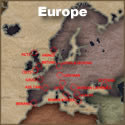Tattoos in Early Germany
Germany has a long history of body decoration. In 1988, a carved figure was found in a cave at Hohlenstein-Stadel, in Germany and was carbon-dated
to 32,000 years old. The body had thin lines running across the upper arm.
Frederich Barbarossa - Red Beard, Roman King and emperor of Germany from 1152 to 1190, had cross
designs on the back of his hands. Dominican priest and German mystic Heinrich Suso (1295-1366)
tattooed the name of Christ over his heart
Kaiser Wilhelm, who was emperor in 1908, was rumored to have an eagle tattooed on his chest. German ports on the North and
Baltic Seas added a naval component to German tattoo history.
There have been many German attractions in sideshows on both sides of the
Atlantic. One of the first professional tattooists in the United States was a
German immigrant named Martin Hildebrandt. His daughter, Nora was the first female tattoo attraction in
the United States in the 1860's. During the Civil War they moved from camp to
camp, with her father Martin tattooing soldiers from both the North and the South.
Nora's pitch was that she and her father were kidnapped by Chief Sitting Bull and his
tribe who tied
her to a tree and forced her father to tattoo her every day for a year to earn
their freedom. Supposedly that was why she boasted of having 365 tattoos from head to
toe.
She appeared in Brunnell's Museum in New York City in 1882.
During the Holocaust, concentration camp prisoners received tattoos at the
Auschwitz concentration camp complex. The camp authorities assigned more than
400,000 prisoner serial numbers (not counting approximately 3,000 numbers given
to police prisoners interned at Auschwitz due to overcrowding in jails who were
not included in the daily count of prisoners).
Some tattoo marks were used by societies as signals of recognition. In Bavaria
and the south of Germany the highway robbers, who are united into a real
association, recognize each other the epigraphic tattoo marks T. and L. meaning
"Thal und Land" (valley and country).
Tattoo Museum Bibliography, Resources and Links
 See all European Tattoo Culture Articles here
See all European Tattoo Culture Articles here
NEXT >>
Thailand Tattoos
